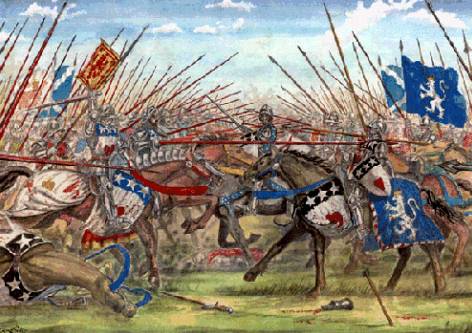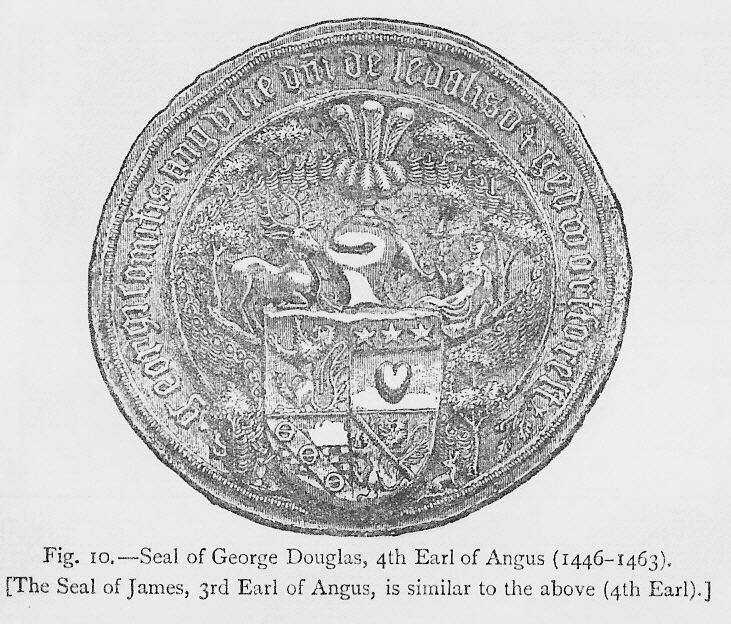George, 4th Earl of Angus

George, 4th Earl of Angus defeating the Black Douglases
at the Battle of Arkinholm, 1455
Image courtesy of Andrew Spratt
George Douglas, 4th Earl of Angus, Lord Douglas, Abernethy and
Jedburgh Forest (c. 1427 – 12 March 1463) was a Scottish Nobleman.
He was the son of William Douglas, 2nd Earl of Angus and Margaret
Hay of Yester. Known as the Great Earl of Angus, he succeeded to the
Earldom following the death of his childless brother
James Douglas,
3rd Earl of Angus in 1446. He was to become the first Red Chief of
Douglas.
The chief line of the family were the Earls of
Douglas which represented the "Black" line, whereas Angus
represented the "Red" Line. Both branches were descended through
bastardy from William the Hardy, Lord of Douglas. The Earl of
Douglas descended through Archibald the Grim, an illegitimate son of
Sir James Douglas. The 4th Earl of Angus' grandfather was an
illegitimate child of William, 1st Earl of Douglas.
Although
the representatives of both lines of the House wore the "three stars
argent" and "Man's Heart gules" on their arms the 4th Earl of Angus
and the 8th Earl of Douglas were third cousins. Angus had closer
ties with the House of Stewart than his Douglas cousins however,
being the great-grandson of Robert III of Scotland through his
grandmother Princess Mary of Scotland, Countess of Angus. This was
to have major implications in the downfall of the Black Douglases
and the rise of the Red line.
In June 1448, Angus joined with
his kinsmen the Earl of Douglas and his brother Hugh Douglas, Earl
of Ormonde on a punitive raid into England and despoiled the
countryside as far as Alnwick which they burnt and "come hame wele".
This was in response to attacks led by the Earl of Northumberland
and Robert Ogle in which they had burnt
Dunbar Castle in the east,
and by the Earl of Salisbury who had laid waste to Dumfries in the
west. The score was evened in July when the Douglases invested
Warkworth Castle and "did gret scaith" and the victory over
Northumberland at the Battle of Sark.
This action in 1448
would be the last time that the two branches of the House of Douglas
would act in partnership, and ride together against their hereditary
foes of Percy and Neville. In 1449 Angus was made Warden of the
Middle Marches.
In 1452 the 8th Earl of Douglas was murdered
at Stirling Castle, by his monarch James II while under assurances
of safe-conduct. Other notable magnates assisted the drunken King
James in the act. The whole of Douglasdale rose in rebellion under
the late Earl's younger brothers,
James the new 9th Earl of Douglas,
his twin Archibald Douglas, Earl of Moray, and the younger Hugh
Douglas, Earl of Ormonde, and John Douglas, Lord of Balvenie. During
this time of intermittent internecine strife in Scotland, it would
have been expected that Angus would have thrown his lot in with his
Douglas cousins. If this had been the case it could have spelled
disaster for the House of Stewart. Contemporary opinion would not
have been surprised if he had, but as alluded above the ties of
kinship were closer between Angus and King James were close, being
first cousins within one degree. A magnate as powerful as Angus
could not abstain from declaring himself either way. So, when the
rebellion began in earnest in early 1455, and the King took to the
field against the Douglas brothers, Angus came out in full support
of his Monarch, and was given high command within the Royal army. It
has been suggested that Angus accompanied the King at the siege of
Abercorn. Following the defection of James Hamilton, 1st Lord
Hamilton, Douglas' chief lieutenant to the King's side, the Earl of
Douglas fled to England in an attempt to gain support from Henry VI
of England. Douglas' brothers stayed in Scotland to continue the
struggle. The brothers had appeared in force in Annandale and King
James sent Angus to deal with them. Angus mustered the Border Clans
and encountered the rebels on the 18th of May near Langholm. The
ensuing Battle of Arkinholm was a rout for the Douglas brothers,
Moray was killed and Ormonde captured (to be executed soon after)
and only Balvenie escaped to England. That summer the Black
Douglases were attainted and their estates declared forfeit. Angus
appended his seal to the charter in token of approval.
Following the acts of attainder Angus received the vast fiefdom and
superiority of the Lordship of Douglas, obtaining a charter of
confirmation in 1457.
In 1460, Angus accompanied King James'
to the siege of English held Roxburgh Castle. The castle, as well as
having been a thorn in the side of successive Scottish monarchs,
also contained a garrison loyal to the House of York, James had
decided to back the House of Lancaster. On the 3rd of August James'
queen, Mary of Gueldres had arrived to inspire enthusiasm amongst
the besiegers. Perhaps too much, James overseeing the cannonade to
greet his wife, was standing too close to one of the bombards when
it exploded, killing him, and wounding his constant companion Angus.
Angus, though wounded, was still able to take command of much of the
siege, and the castle was successfully stormed and taken within the
week. Furthermore, he was able to attend the coronation of James III
at Kelso Abbey on the 10th of August, where he placed the Crown upon
the nine year old King's head, as was his right as Lord Abernethy,
apparently proclaiming: "There! Now that I have set it upon your
Grace's head, let me see who will be so bold as to move it."
Angus' had already become enormously powerful during the reign of
James II and during the Regency for his son, his power continued to
grow. The Scots parliament had decreed following the forfeiture of
the Black Douglases, that no Douglas should have the hereditary
right to the wardenship of the Marches, Angus continued to exercise
command over the East and Middle Marches, and was appointed
lieutenant of the Realm by the Queen-regent Mary of Gueldres.
In the following year Angus spent a great deal of time
consolidating his estates, placing trusted vassals in charge of the
more far flung estates. 1462 saw Angus receive all of the goods
lands and rents of the adherents of the forfeited Douglases in
Roxburghshire, apart from those already owned by his brother William
Douglas of Cluny.
In the same year Angus was involved in
negotiations with the Lancastrian Henry VI of England. Henry had
obtained a bond from Angus to aid him with "a stipulated force for
the recovery of that realm [England] from Henry's rebels and
enemies". For Henry's part he promised Angus, on the recovery of his
kingdom "to make the saide erle sufficiently and suerly after the
lawes of England a duke withynne the said reavme of England, with
stile, astate, honure and name of a duke", the dukedom was to come
with a castle and land to the value of 2000 marks.
Angus was
unable to pursue his plans for an English dukedom, when he died on
the 12th of March 1463 at Abernethy.
Angus was a commissioner
sent to treat with the English twice, in 1449 and in 1459.
Ambassador to England in 1451
Warden of the East and Middle
Marches 1455–1462
George Douglas, 4th Earl of Angus married
prior to his accession, Isabella Sibbald. They had nine children:
Archibald Douglas, 5th Earl of Angus
John Douglas
Anne
Douglas, married William Graham, 3rd Lord Graham
Isabella
Douglas, married Sir Alexander Ramsay
Elizabeth Douglas, married
1. Alexander (of Dalhousie) Ramsay
2. Thomas Livingstone
3. Robert (2nd of Fintry) Graham
Margaret Douglas, married sir Duncan Campbell of Glenorchy
Janet
Douglas, married 1st Duncan Scott younger of Buccleuch, 2nd George
Leslie, 1st Earl of Rothes
Egidia Douglas
Alice Douglas

Any contributions will be
gratefully accepted
Errors and Omissions
|
|
The Forum
|
|
What's new?
|
|
We are looking for your help to improve the accuracy of The Douglas
Archives.
If you spot errors, or omissions, then
please do let us know
Contributions
Many articles are stubs which would benefit from re-writing.
Can you help?
Copyright
You are not authorized to add this page or any images from this page
to Ancestry.com (or its subsidiaries) or other fee-paying sites
without our express permission and then, if given, only by including
our copyright and a URL link to the web site.
|
|
If you have met a brick wall
with your research, then posting a notice in the Douglas Archives
Forum may be the answer. Or, it may help you find the answer!
You may also be able to help others answer their queries.
Visit the
Douglas Archives Forum.
2 Minute Survey
To provide feedback on the website, please take a couple of
minutes to complete our
survey.
|
|
We try to keep everyone up to date with new entries, via our
What's New section on the
home page.
We also use
the Community
Network to keep researchers abreast of developments in the
Douglas Archives.
Help with costs
Maintaining the three sections of the site has its costs. Any
contribution the defray them is very welcome
Donate
Newsletter
If you would like to receive a very occasional newsletter -
Sign up!
Temporarily withdrawn.
|
|
|
|
|
|
|
|


